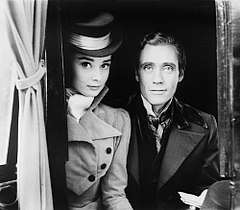War and Peace (1956 film)
War and Peace (Italian: Guerra e pace) is a 1956 epic historical drama film based on Leo Toltsoy's 1869 novel of the same name. It was directed by King Vidor with a screenplay by Vidor, Bridget Boland, Mario Camerini, Ennio De Concini, Gian Gaspare Napolitano, Ivo Perilli, Mario Soldati, and Robert Westerby. The film, an Italian-American co-production released by Paramount Pictures, was produced by Dino De Laurentiis and Carlo Ponti with a music score by Nino Rota and cinematography by Jack Cardiff.
| War and Peace | |
|---|---|
_03.jpg) Theatrical release poster | |
| Directed by | King Vidor |
| Produced by | Dino De Laurentiis |
| Screenplay by |
|
| Based on | War and Peace by Leo Tolstoy |
| Starring | |
| Music by | Nino Rota |
| Cinematography | Jack Cardiff |
| Edited by | Leo Cattozzo |
Production company | Ponti-De Laurentiis Cinematografica |
| Distributed by |
|
Release date |
|
Running time | 208 minutes |
| Country |
|
| Language | English |
| Budget | $6 million |
| Box office | 15,707,723 admissions (Italy)[1] $6.25 million (US and Canadian rentals)[2] |
The film stars Audrey Hepburn as Natasha, Henry Fonda as Pierre, and Mel Ferrer as Andrei, along with Oskar Homolka, Vittorio Gassman, Herbert Lom, John Mills and Anita Ekberg, in one of her first breakthrough roles. It had Oscar nominations for Best Director (King Vidor), Best Cinematography, Color (Jack Cardiff) and Best Costume Design, Color (Maria De Matteis).
In February 2020, the film was shown at the 70th Berlin International Film Festival, as part of a retrospective dedicated to King Vidor's career.[3]
Cast
- Audrey Hepburn as Natasha Rostova
- Henry Fonda as Count Pierre Bezukhov
- Mel Ferrer as Prince Andrei Bolkonsky
- Oskar Homolka as General Mikhail Kutuzov
- Anita Ekberg as Hélène Kuragina
- Vittorio Gassman as Anatole Kuragin
- Herbert Lom as Napoleon Bonaparte
- Helmut Dantine as Dolokhov
- Tullio Carminati as Prince Vasily Kuragin
- Barry Jones as Count Rostov
- Milly Vitale as Lise
- Lea Seidl as Countess Rostova
- Anna Maria Ferrero as Mary Bolkonskaya
- Wilfrid Lawson as Prince Bolkonsky
- May Britt as Sonya Rostova
- Jeremy Brett as Nicholas Rostov
- John Mills as Platon Karatayev
- Patrick Crean as Denisov
- Seán Barrett as Petya Rostov
- Alan Furlan as Russian officer
Differences from the novel
The film script had to be greatly condensed from the extensive original novel. It is primarily focused on Natasha, Pierre, and Andrei, their complex relationship and personal maturation on the backdrop of the historical events of the Napoleonic invasion.
- In Moscow, most of the scenes take place at the Rostov residence, and episodes at the country estates are curtailed, with some exceptions such as the hunt where Natasha first meets Andrei. This is a condensation of two scenes at the Rostov country estate, since in the novel Andrei, who by then is already Natasha's fiancé, is not present at the hunt.
- There are no scenes in St. Petersburg.
- The relationship between Nicholas, Sonya and Maria is toned down.
- Historical figures retained are General Kutuzov and Napoleon.
- Minor battles are omitted, while Napoleon's crossing of the Berezina, not depicted in the novel, is added.
- The concept of the inner dialogue is retained, notably in regard to Natasha, but the extensive use of French is not retained in the film.
- Events of the epilogue are not included, nor are Tolstoy's discourses about history.
Reception
The film received mixed reviews from critics. Rotten Tomatoes reports that 33% of 6 reviews were positive, with an average rating of 4.8/10.[4]
The film is the Italian film with the most number of admissions in Italy with 15,707,723 admissions.[1]
The film is recognized by American Film Institute in these lists:
- 2005: AFI's 100 Years of Film Scores – Nominated[5]
- 2008: AFI's 10 Top 10:
- Nominated Epic Film[6]
Gallery
 Audrey Hepburn and Mel Ferrer on the set of War and Peace in 1955
Audrey Hepburn and Mel Ferrer on the set of War and Peace in 1955 Screenshot of Audrey Hepburn in the role of Natasha and Mel Ferrer as Prince Andrei
Screenshot of Audrey Hepburn in the role of Natasha and Mel Ferrer as Prince Andrei
See also
- List of American films of 1956
- War and Peace - 1941 opera composed by Sergei Prokofiev
- War and Peace - 1966-67 film series directed by Sergei Bondarchuk
- War and Peace - 1972 TV 20-part BBC Production
- War and Peace - 2007 TV 4-Part French-Italian mini series
- War & Peace - 2016 British-American TV mini series, BBC and A&E Production
References
- "La classifica dei film più visti di sempre al cinema in Italia". movieplayer.it. January 25, 2016. Retrieved October 4, 2019.
- "The Top Box-Office Hits of 1956". Variety. January 2, 1957.
- "Berlinale 2020: Retrospective "King Vidor"". Berlinale. Retrieved February 28, 2020.
- "War and Peace (1956)". Rotten Tomatoes. Flixster. Retrieved November 24, 2015.
- "AFI's 100 Years of Film Scores Nominees" (PDF). Retrieved August 13, 2016.
- "AFI's 10 Top 10 Nominees" (PDF). Archived from the original on July 16, 2011. Retrieved August 19, 2016.CS1 maint: BOT: original-url status unknown (link)
External links
| Wikimedia Commons has media related to War and Peace (1956 film). |